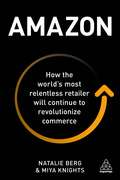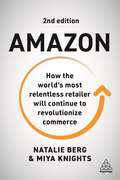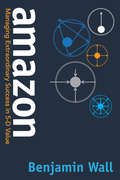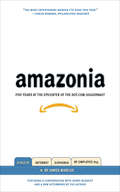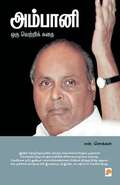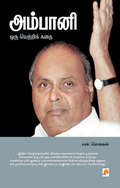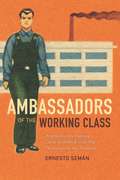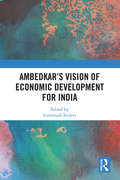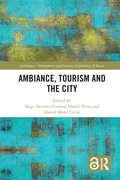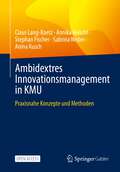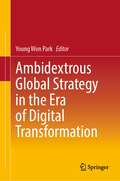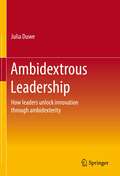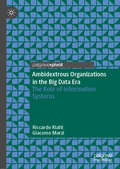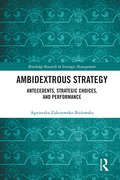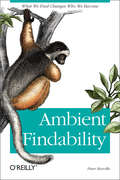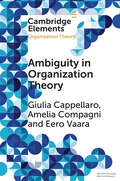- Table View
- List View
Amazon.com: The Brink of Bankruptcy
by Lynda M. ApplegateEnables a thorough analysis of the Amazon.com business model and its evolution from 1994 to 2001. The case ends with the company poised on the brink of bankruptcy, and enables discussion of how to turnaround the company and leverage proprietary assets.
Amazon: Cult or Culture?
by Boris Groysberg Sarah L. Abbott Tricia GreggAmazon was one of the first entrants in e-commerce. Under the leadership of founder Jeff Bezos, Amazon had expanded beyond books to manufacturing and selling a wide range of products and services globally. Bezos had built a customer-centric culture that permeated all aspects of the company. As Amazon continued to grow and expand into new business areas, would it be able to maintain its culture and practices? How much of Amazon's success depended on the cult of Bezos? As the company continued to diversify beyond Bezos's immediate oversight, what could Amazon do to ensure that it stayed relentless?
Amazon: How the World’s Most Relentless Retailer will Continue to Revolutionize Commerce
by Natalie Berg Miya KnightsThe retail industry is facing unprecedented challenges. Across all sectors and markets, retailers are shifting their business models and customer engagement strategies to ensure their survival. The rise of online shopping, and its primary player, Amazon, is at the heart of many of these changes and opportunities. Amazon explores the e-commerce giant's strategies, providing original insight at a time when the company is on the cusp of revolutionizing itself even further. Amazon's relentless dissatisfaction with the status quo is what makes it such an extraordinary retailer. This book explores whether Amazon has what it takes to become a credible grocery retailer, and as it transitions to bricks and mortar retailing, explores whether Amazon's stores can be as compelling as its online offering and if innovations such as voice technology, checkout-free stores and its Prime ecosystem will fundamentally change the way consumers shop.Written by industry leading retail analysts who have spent decades providing research-based analysis and opinion, Amazon analyzes the impact these initiatives will have on the wider retail sector and the lessons that can be learned from its unprecedented rise to dominance, as stores of the future become less about transactions and more about experiences.
Amazon: How the World’s Most Relentless Retailer will Continue to Revolutionize Commerce
by Natalie Berg Miya KnightsAmazon - one of the world's most valuable companies - is worth more than Walmart, Netflix, Target, Nike and Costco combined. What are the secrets to its success? How can these insights be applied to other businesses in the e-commerce sector? The retail industry is facing unprecedented challenges. Across all sectors and markets, retailers are shifting their business models and customer engagement strategies to ensure they survive. Amazon offers unique insight into the company's persistent dissatisfaction with the status quo and innovation and how it has fundamentally changed the ways in which we shop. This fully updated second edition explores Amazon's response to the coronavirus pandemic, the convergence of physical and digital retail, e-commerce economics and sustainability, as well as future policy implications. Written by industry-leading retail analysts and with the first edition now translated into more than a dozen languages, Amazon is an invaluable resource for discovering the lessons that can be learned from the company's unprecedented rise to dominance.
Amazon: Managing Extraordinary Success in 5-D Value
by Benjamin WallIn Amazon: Managing Extraordinary Success in 5-D Value, Benjamin Wall offers structured insights into strategically managing value in the key relationships to customers, personnel, business partners, and investors in order to improve value management at any company.The extraordinary success of Amazon is due to market-leading strength in three &“dimensions&” of value: owning the mightiest supply chain to deliver fastest and cheapest the broadest range of products, enhancing what customers and business partners are doing when using the website / online ecosystem, and knowing how to implement the optimal terms and conditions in the after-sales customer experience. Wall takes a look at the unique managerial skill of Amazon and how each of these organizational areas operates externally and internally according to a separate business logic based on a dimension of value.In an original examination, Wall systematically evaluates Amazon by categorizing and connecting its external and internal success factors to dimensions of value. Each &“score&” on an external success factor is linked to an internal success factor in managing processes, organizational culture, and the business model, so that managers and leaders can enhance their own internal success factors and move towards the same successful external factors. Amazon looks to the future where the near-term promise of the company is evaluated to be in the development from online to omnichannel retail, including the sale of services, by reviving out of Amazon&’s past the fourth dimension of value: feeling how to integrate value. The long-term potential of Amazon is set in the context of a sustainable future for retail, based on trends arising today in meaning across multiple communities, which is the emerging fifth dimension of value. Amazon is projected to operate in this value dimension again as a disruptor, and with Wall&’s help, managers and leaders can reach for the same kind of success.
Amazon: The Brink of Bankruptcy
by Lynda M. ApplegateEnables a thorough analysis of the Amazon.com business model and its evolution from 1994 to 2001. The case ends with the company poised on the brink of bankruptcy, and enables discussion of how to turnaround the company and leverage proprietary assets.
Amazon: The Brink of Bankruptcy
by Lynda M. ApplegateEnables a thorough analysis of the Amazon.com business model and its evolution from 1994 to 2001. The case ends with the company poised on the brink of bankruptcy, and enables discussion of how to turnaround the company and leverage proprietary assets.
AmazonFresh: Rekindling the Online Grocery Market
by Clayton M. Christensen Rory Mcdonald Robin Yang Ty HollingsworthMore than a decade after the high-profile failures of several early online grocers, grocery remains the largest single U.S. retail category and one of the few that has not yet migrated online. Amazon began testing its grocery-delivery service, AmazonFresh, in Seattle, in 2007; five years later, the company has made significant progress. The case traces the evolution of AmazonFresh's business model and describes the operating capabilities necessary to compete with brick-and-mortar supermarkets like Wal-Mart and Safeway and with new digital grocery startups. Now Amazon needs to decide on AmazonFresh's next step. Should the company continue refining its business model in Seattle or expand to another city? What factors should it take into account when planning its next move?
Amazonia: Five Years at the Epicenter of the Dot.Com Juggernaut
by James MarcusFive years at the epicenter of the dot.com juggernaut
Amazonia: Five Years at the Epicenter of the Dot.com Juggernaut
by James MarcusA &“funny, contemplative&” memoir of working at Amazon in the early years, when it was a struggling online bookstore (San Francisco Chronicle). In a book that Ian Frazier has called &“a fascinating and sometimes hair-raising morality tale from deep inside the Internet boom,&” James Marcus, hired by Amazon.com in 1996—when the company was so small his e-mail address could be james@amazon.com—looks back at the ecstatic rise, dramatic fall, and remarkable comeback of the consummate symbol of late 1990s America. Observing &“how it was to be in the right place (Seattle) at the right time (the &’90s)&” (Chicago Reader), Marcus offers a ringside seat on everything from his first interview with Jeff Bezos to the company&’s bizarre Nordic-style retreats, in &“a clear-eyed, first-person account, rife with digressions on the larger cultural meaning throughout&” (Henry Alford, Newsday). &“Marcus tells his story with wit and candor.&” —Booklist, starred review
Ambani
by N. ChokkanThis book is a biography of Dhirubai Ambani who won the prestigious best industrialist of India of the 20th century award from "Business Barons" in 1999 and who started his life from a humble beginning with moderate education to achieve Himalayan victory in business world with high enterprising ability.
Ambani: Oru Vetri Kadhai
by N. ChokkanThis book tells the success story of the Indian industrialist Dhirubai Ambani.
Ambani: அம்பானி
by என். சொக்கன்"இந்தியாவில் தொழில்முனைவோராக விரும்புபவர்களுக்கெல்லாம் முக்கிய ஆதர்சமாகத் திகழ்பவர் திருபாய் அம்பானி. மிகச் சாதாரணப் பின்னணியிலிருந்து தொடங்கி படிப்படியாக முன்னேறி ரிலையன்ஸ் எனும் மாபெரும் சாம்ராஜ்ஜியத்தை உருவாக்கியவர் திருபாய் அம்பானி. துணிமணி வியாபாரத்திலிருந்து ஆரம்பித்து, அதன்பின் துணிகளைத் தயாரித்து, பின் பாலியெஸ்டர் வியாபாரம், பாலியெஸ்டர் உற்பத்தி, அதன்பின் பாலியெஸ்டர் உற்பத்திக்கான மூலப்பொருள்களை உருவாக்குவது, அந்த மூலப்பொருள்களின் ஆதாரமான பெட்ரோலிய சுத்திகரிப்பு, அங்கிருந்து பெட்ரோலையே தரையிலிருந்தும், கடலுக்கு அடியிலும் தோண்டுவது என்று படிப்படியாக, பார்த்துப் பார்த்து தன் தொழிற்சாலைகளைக் கட்டியவர். அம்பானி 70 mm அளவுக்கு விரிந்த திரையில் கனவு கண்டார். பிரம்மாண்டமாக மட்டுமே யோசித்தார். அதன் விளைவுதான் இன்று ரிலையன்ஸ் இந்தியாவிலேயே மிகப்பெரிய தனியார் நிறுவனமாக உள்ளது. ஆனால் இத்தனையும் அதிர்ஷ்டத்தால் வந்ததல்ல. உழைப்பால், தைரியத்தால், முயற்சியால் வந்தது. அதே சமயம் காலத்துக்குத் தகுந்தாற்போல அரசுகளையும் அதிகாரிகளையும் தனக்குச் சாதகமாக வளைத்துக் கொள்வதன் மூலமும் அரசு உத்தரவுகளை தன் வசதிக்கேற்றவாறு புரிந்துகொள்வதன் மூலமும் அம்பானி தன் நிறுவனத்தை வளர்த்தார். அம்பானி, தன்னை எதிர்ப்பவர்களை அவர்களது ஆயுதங்களைக் கொண்டே மழுங்கடித்தார். இன்றைய காலகட்டத்தில் திருபாய் அம்பானியின் சில செயல்கள் நமக்கு ஏற்புடையதாக இருக்காது. ஆனால் அவரது விடாமுயற்சி, தன்னம்பிக்கை, இந்தியா மீதான பற்று, சக ஊழியர்கள் மீதான மரியாதை, தொழில் மீதான ஆழ்ந்த பக்தி ஆகியவை இன்றைக்கும் நம் அனைவருக்கும் வழிகாட்டக் கூடியவை. இந்தப் புத்தகம் அம்பானியின் வாழ்க்கை வரலாறு மட்டுமல்ல, கடந்த நாற்பதாண்டுகளில் இந்தியாவின் தொழில்துறையின் வரலாறும் இதில் அடங்கியிருக்கிறது. எந்தவொரு சுய முன்னேற்ற நூலைக் காட்டிலும் பன்மடங்கு அதிகமான பலனை இந்தப் புத்தகத்தினைப் படிப்பதன் மூலம் ஒருவர் அடைய முடியும். இது நிஜமான வாழ்க்கை, வெறும் ஏட்டுச் சுரைக்காய் அல்ல." கிழக்கு பதிப்பகம் | Kizhakku pathippagam
Ambassadors of the Working Class: Argentina's International Labor Activists and Cold War Democracy in the Americas
by Ernesto SemánIn 1946 Juan Perón launched a populist challenge to the United States, recruiting an army of labor activists to serve as worker attachés at every Argentine embassy. By 1955, over five hundred would serve, representing the largest presence of blue-collar workers in the foreign service of any country in history. A meatpacking union leader taught striking workers in Chicago about rising salaries under Perón. A railroad motorist joined the revolution in Bolivia. A baker showed Soviet workers the daily caloric intake of their Argentine counterparts. As Ambassadors of the Working Class shows, the attachés' struggle against US diplomats in Latin America turned the region into a Cold War battlefield for the hearts of the working classes. In this context, Ernesto Semán reveals, for example, how the attachés' brand of transnational populism offered Fidel Castro and Che Guevara their last chance at mass politics before their embrace of revolutionary violence. Fiercely opposed by Washington, the attachés’ project foundered, but not before US policymakers used their opposition to Peronism to rehearse arguments against the New Deal's legacies.
Ambedkar’s Vision of Economic Development for India
by Gummadi SrideviThis book discusses Ambedkar’s engagements with the issues of social justice, economic development and caste enclosures. It highlights his significant contributions in the field of trade, public finance and monetary economics, Indian agriculture, education, among others, and examines their relevance in contemporary India. The volume analyses the basic theoretical conceptions in Ambedkar’s writings which attributed a key role to industrialisation, favoured economic planning and progressive labour laws. It reaffirms these theories and illustrates that focus on social and economic democracy promotes productivity, equitable distribution of wealth and an inclusive society. Through an analysis of Ambedkar’s interdisciplinary works, the book discusses issues of rural poverty, lagging infrastructure growth, the persistence of an exploitative ruling class and the economic and social marginalisation of the downtrodden which are still relevant today. Further, it offers solutions for a restructuring of the society under democratic principles which would recognise the basic right of all to social dignity, and devise means to insure against social and economic insecurity. Insightful and authoritative, this volume will be of great interest to students and researchers of economics, sociology, development studies and social exclusion.
Ambiance, Tourism and the City (Ambiances, Atmospheres and Sensory Experiences of Spaces)
by Iñigo Sánchez-Fuarros Daniel Paiva Daniel Malet CalvoAmbiance, Tourism and the City considers how tourism and urban development affect the lived ambiances of contemporary cities around the world. As most of the existing literature on sensory atmospheres says little about the intersection between tourism and atmospheric production, this book affirms the centrality of the notion of ambiance as a mode of inquiry into the making and remaking of urban places for tourist consumption. The book takes the reader into the sensory worlds of a traditional Italian marketplace, a jungle park in Kuala Lumpur, a slum in the Colombian city of Medellín, or the "sun and sand" tourism destinations in Southern Spain, among other case studies. It offers new insights into the impact of tourism on the urban environment from multidisciplinary perspectives and a wide range of geographical regions across Europe, North America, Asia, and South America. Through these contemporary case studies, the book further deepens our understanding of the ways in which "ambiances" and "atmospheres" pervade the physical regeneration and sensory transformation of contemporary tourist destinations. Conversely, this book offers insights on the effects of tourism on everyday urban experience. By bringing together a diverse group of scholars and case studies to present a global perspective on the atmospheric production of the tourist city, this book is to serve as a valuable reference tool for researchers and undergraduate and postgraduate students with an interest in urban ambiances, tourism, cultural geography, and urban planning.
Ambiance, Tourism and the City (ISSN)
by Iñigo Sánchez-Fuarros Daniel Paiva Daniel Malet CalvoAmbiance, Tourism and the City considers how tourism and urban development affect the lived ambiances of contemporary cities around the world. As most of the existing literature on sensory atmospheres says little about the intersection between tourism and atmospheric production, this book affirms the centrality of the notion of ambiance as a mode of inquiry into the making and remaking of urban places for tourist consumption. The book takes the reader into the sensory worlds of a traditional Italian marketplace, a jungle park in Kuala Lumpur, a slum in the Colombian city of Medellín, or the "sun and sand" tourism destinations in Southern Spain, among other case studies. It offers new insights into the impact of tourism on the urban environment from multidisciplinary perspectives and a wide range of geographical regions across Europe, North America, Asia, and South America. Through these contemporary case studies, the book further deepens our understanding of the ways in which "ambiances" and "atmospheres" pervade the physical regeneration and sensory transformation of contemporary tourist destinations. Conversely, this book offers insights on the effects of tourism on everyday urban experience.By bringing together a diverse group of scholars and case studies to present a global perspective on the atmospheric production of the tourist city, this book is to serve as a valuable reference tool for researchers and undergraduate and postgraduate students with an interest in urban ambiances, tourism, cultural geography, and urban planning.
Ambidextres Innovationsmanagement in KMU: Praxisnahe Konzepte und Methoden
by Sabrina Weber Stephan Fischer Claus Lang-Koetz Annika Reischl Anina KuschDieses Open-Access-Buch vermittelt praxisnahes Wissen über Konzepte und Methoden für das Innovationsmanagement in kleinen und mittleren Unternehmen (KMU). Es werden Lösungsansätze für Herausforderungen im gesamten Innovationsprozess – von der strategischen Orientierung über Ideengewinnung, -bewertung und auswahl bis zur Umsetzung – aufgezeigt. Der Hauptfokus liegt auf dem Umgang mit Ambidextrie: Vorhandene Ressourcen sind zu nutzen, um das Tagesgeschäft effizient zu bewältigen und inkrementelle Innovationen zu entwickeln (Exploitation). Gleichzeitig soll offen nach ganz neuen und oftmals radikalen Innovationen gesucht werden (Exploration). Ein Kapitel zeigt, wie KMU ihr Innovationsmanagement auf das Thema Nachhaltigkeit ausrichten können. Auf der Webseite der Hochschule Pforzheim finden sich zahlreiche vertiefende Zusatzmaterialien. Der InhaltStrategische Orientierung/ProblemidentifizierungIdeengewinnung, -bewertung, -auswahl und -umsetzungAmbidextrie und das hybride VorgehenZukunft des Innovationsmanagements: Nachhaltigkeit
Ambidextrous Global Strategy in the Era of Digital Transformation
by Young Won ParkThis book deals with the importance of ambidexterity in innovation activities and global strategies. Ambidextrous global strategy (AGS) is crucial for global firms in the turbulent twenty-first century. Here, AGS is defined as simultaneous achievements of global integration and local adaptation, or responsiveness, through utilization of a firm’s core facilities and organizational capabilities. To illustrate the specific implementation mechanism, a framework of AGS with global market strategy and organizational capability is shown for the purpose of analysis. There is also a focus on effective ambidextrous business strategies for the digital transformation era. Distinctive features of the book include, first, a framework of ambidextrous innovation and AGS. Second, there are analyses of examples of many industries to implement ambidexterity strategies, including Korean shipbuilding firms, Korean and Japanese steel firms, LCD panel flat-glass manufacturers, Japan’s trucking industry, agricultural corporations, and other Japanese manufacturing firms. Finally, the book focuses on effective ambidextrous business strategies for the digital transformation era with the integration of open and closed innovation. The book presents specific business strategies for survival in the digital transformation era and then suggests an architectural analysis using artificial intelligence (AI) for the realization of AGS. The target readership is made up of academics, students, and practitioners in the areas of global management, organizational theory, and strategic management. Especially for those readers, the book clarifies the critical practices and business strategies of innovative global firms in the era of digital transformation.
Ambidextrous Leadership: How leaders unlock innovation through ambidexterity
by Julia DuweThis book prepares leaders for fundamental change processes of organizations. In times of radical changes and unplanned crises, ambidexterity has become a key competence of global companies. Ambidextrous organizations manage to improve their core business, while at the same time opening up new business fields for the future. To unlock innovation next to the running business, it is essential for leaders to be ambidextrous. How these balanced leaders can operate with two different styles is demonstrated in numerous practical examples and tips for successful implementation. The book illustrates how the trade-off can be turned into an elegant balancing act. Learn how to become an ambidextrous leader in this standard work on ambidexterity and leadership. · Ambidexterity as a leadership approach for the digital transformation· Consciously shaping the digital change process· Enabling leaps in innovation· Driving evolution and revolution simultaneously· The relevance of ambidextrous leadership in times of crisis The book provides easy-to-implement courses of action for executives to consciously and actively shape change, to inspire people in companies to release their creative potential and to make the leap into the future as an organization. The book also addresses the consequences of the COVID-19 pandemic on crisis management. It documents how ambidextrous leadership skills are becoming a key competence in times of crisis.
Ambidextrous Organizations in the Big Data Era: The Role of Information Systems
by Riccardo Rialti Giacomo MarziAddressing the effect of big data analytics-capable information systems on organizational ambidexterity, this book investigates how these systems can be used to enhance organizational agility and flexibility, generally considered to be two key determinants of organizational ambidexterity. With a focus on the opportunities for businesses rather than the burden that big data can represent, the authors highlight the impact of big data on ambidextrous organizations and how current organizational structures can be modified in order to improve big data analytics and implement big data-capable information systems.
Ambidextrous Organizations: Leading Evolutionary and Revolutionary Change
by Michael L. Tushman Charles A. O'ReillyWhile less successful firms react to environmental jolts, the more successful ones proactively initiate innovations that reshape their market. This chapter discusses the importance of managing an organization that can succeed at both incremental and radical innovation.
Ambidextrous Strategy: Antecedents, Strategic Choices, and Performance (Routledge Research in Strategic Management)
by Agnieszka Zakrzewska-BielawskaStrategies of enterprises evolve with the development of strategic management theory and new concepts, models, and outlooks that emerge with it. The concept of ambidexterity is a relatively new approach to business development strategies, which involves simultaneous exploration and exploitation activities to ensure the success of the company and a relatively sustainable competitive advantage. This begs the question as to whether the ambidextrous strategy is the right choice for all enterprises, and if not, what determines its choice. This book identifies and systematizes antecedents for choosing ambidextrous strategy, including factors related to the uncertainty of the environment, its dynamics, complexity, and unpredictability, intra-organizational factors, those related to resources, organizational structure, and behavioral context, as well as those related to strategic leadership. It examines the outcomes of implementing ambidexterity from the perspective of financial and market performance and assesses the choices of companies operating in Poland from the perspective of the impact that particular antecedents had and the outcomes achieved, providing knowledge and guidance on the circumstances in which choosing the ambidextrous strategy brings the best results. The book presents the research findings to date, the cognitive gaps that still exist, and the directions for further research. It is intended for scientific circles, doctoral and management students and a wide range of managers, who have to make difficult strategic choices aimed, on the one hand, at increasing the efficiency of the company and, on the other, at seeking new paths of growth.
Ambient Findability: What We Find Changes Who We Become
by Peter MorvilleHow do you find your way in an age of information overload? How can you filter streams of complex information to pull out only what you want? Why does it matter how information is structured when Google seems to magically bring up the right answer to your questions? What does it mean to be "findable" in this day and age? This eye-opening new book examines the convergence of information and connectivity. Written by Peter Morville, author of the groundbreaking Information Architecture for the World Wide Web, the book defines our current age as a state of unlimited findability. In other words, anyone can find anything at any time. Complete navigability.Morville discusses the Internet, GIS, and other network technologies that are coming together to make unlimited findability possible. He explores how the melding of these innovations impacts society, since Web access is now a standard requirement for successful people and businesses. But before he does that, Morville looks back at the history of wayfinding and human evolution, suggesting that our fear of being lost has driven us to create maps, charts, and now, the mobile Internet.The book's central thesis is that information literacy, information architecture, and usability are all critical components of this new world order. Hand in hand with that is the contention that only by planning and designing the best possible software, devices, and Internet, will we be able to maintain this connectivity in the future. Morville's book is highlighted with full color illustrations and rich examples that bring his prose to life.Ambient Findability doesn't preach or pretend to know all the answers. Instead, it presents research, stories, and examples in support of its novel ideas. Are we truly at a critical point in our evolution where the quality of our digital networks will dictate how we behave as a species? Is findability indeed the primary key to a successful global marketplace in the 21st century and beyond. Peter Morville takes you on a thought-provoking tour of these memes and more -- ideas that will not only fascinate but will stir your creativity in practical ways that you can apply to your work immediately."A lively, enjoyable and informative tour of a topic that's only going to become more important."--David Weinberger, Author, Small Pieces Loosely Joined and The Cluetrain Manifesto"I envy the young scholar who finds this inventive book, by whatever strange means are necessary. The future isn't just unwritten--it's unsearched."--Bruce Sterling, Writer, Futurist, and Co-Founder, The Electronic Frontier Foundation"Search engine marketing is the hottest thing in Internet business, and deservedly so. Ambient Findability puts SEM into a broader context and provides deeper insights into human behavior. This book will help you grow your online business in a world where being found is not at all certain."--Jakob Nielsen, Ph.D., Author, Designing Web Usability: The Practice of Simplicity"Information that's hard to find will remain information that's hardly found--from one of the fathers of the discipline of information architecture, and one of its most experienced practitioners, come penetrating observations on why findability is elusive and how the act of seeking changes us."--Steve Papa, Founder and Chairman, Endeca"Whether it's a fact or a figure, a person or a place, Peter Morville knows how to make it findable. Morville explores the possibilities of a world where everything can always be found--and the challenges in getting there--in this wide-ranging, thought-provoking book."--Jesse James Garrett, Author, The Elements of User Experience"It is easy to assume that current searching of the World Wide Web is the last word in finding and using information. Peter Morville shows us that search engines are just the beginning. Skillfully weaving together information science research with his own extensive experie
Ambiguity in Organization Theory: From Intrinsic to Strategic Perspectives (Elements in Organization Theory)
by Eero Vaara Giulia Cappellaro Amelia CompagniThis Element presents and discusses the main trajectories in the evolution of the concept of ambiguity and the most relevant theoretical contributions developed around it. It specifically elaborates on both the intrinsic perspectives on ambiguity as an inherent part of organizational decision-making processes and the more recent strategic perspectives on discursively constructed strategic ambiguity. It helps illuminate the path ahead of organizational scholars and offers new avenues for future research. This is important given the ever more pervasive presence of ambiguity in and around organizations and societies.

